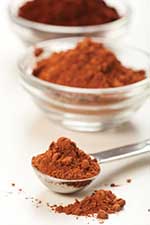Brazilians Perk Up to Premium Coffee; Reducing Bacteria on Tomatoes
NEWS
 Brazilians perk up to premium coffee
Brazilians perk up to premium coffee
More Brazilians are choosing premium coffee over regular brands, with 25% of coffee drinkers choosing to drink high quality brews in the second-largest market for coffee in the world, reports market research firm Mintel.
“As Brazilians get more demanding about their coffee, the country’s better quality Arabica beans will increasingly be used to service its burgeoning domestic market, rather than merely sent overseas,” said Jonny Forsyth, global drinks analyst at Mintel.
One reason for the interest is the increase in coffee shops in Brazil. It is at these shops where consumers will often be first exposed to premium and specialty coffees. Mintel data show that about a third of Brazilian coffee consumers who report that they prefer premium coffee consume it at a coffee shop.
It is not only premium coffee that is growing in popularity in Brazil but also coffee in general. As the overall market volume for coffee in Brazil continues to grow faster than that of the United States, the country is expected to take over the number one spot within the next few years, according to Mintel’s research findings.
Using umami to enhance salty taste
Formulating meat with natural umami-containing ingredients enhances umami and salty taste characteristics, positively improving liking by some consumers, and may offer a way to improve the taste of foods without adding salt or monosodium glutamate (MSG), according to a study published in Journal of the Science of Food and Agriculture.
Researchers with University of Reading in the United Kingdom added umami ingredients (yeast extract, mycoscent, shiitake extract, tomato puree, soy sauce, and soybean paste) or MSG to meat products during cooking and then compared those samples with a control sample to determine sensory attributes and liking by younger and older subjects. The results showed that a significantly higher amount of umami-containing compounds developed in four of the seven cooked meat products compared with the control. A trained sensory panel scored all of the cooked meat products except those that contained tomato puree and MSG as having a higher umami and/or salty taste perception compared with the control. Finally, there was a correlation of liking by the older subjects with perceived saltiness.
The study, “Maximising Umami Taste in Meat Using Natural Ingredients: Effects on Chemistry, Sensory Perception and Hedonic Liking in Young and Old Consumers,” appeared in Journal of the Science of Food and Agriculture, doi: 10.1002/jsfa.6177.
Reducing bacteria on tomatoes
A treatment combining UV-C light and low-dose ionizing radiation successfully reduced Salmonella enterica and Escherichia coli O157:H7 on the surface of grape tomatoes with minimal effects on some sensory and nutritional attributes, reported researchers with the U.S. Dept. of Agriculture’s Agricultural Research Service.
The researchers inoculated whole grape tomatoes with the bacteria and subjected the samples to UV-C (253.7nm) dose of 0.6 kJ/m2 followed by 4 different low doses of gamma irradiation (0.1 kGy, 0.25 kGy, 0.5 kGy, or 0.75 kGy). The results showed a 5 log reduction in pathogens by combining UV-C (at 0.6 kJ/m2) with 0.75 kGy of gamma irradiation. The dose was within the FDA permissible limit of 1 kGy.
The study, “Efficacy of Integrated Treatment of UV light and Low-Dose Gamma Irradiation on Inactivation of Escherichia coli O157:H7 and Salmonella enterica on Grape Tomatoes,” appeared in the July 2013 issue of Journal of Food Science.
Sustainable facility opens at UC Davis
The University of California, Davis, recently celebrated the opening of the Jess S. Jackson Sustainable Winery Building. The $4 million structure will allow the adjacent Teaching and Research Winery and August A. Busch III Brewing and Food Science Laboratory to operate in a sustainable manner through onsite capture of energy and water.
Plans for the one-story, 8,500-sq-ft building include housing equipment for capturing and sequestering carbon dioxide from wine fermentation, and for filtering and recirculating water for wine, beer, and food processing. The university expects it to be the first certified Net Zero Energy building under the Living Building Challenge at any university and the second such building in California.
In addition to accommodating the systems for capturing energy and water, the building’s architectural design even keeps in mind future expansion for additional sustainable advances; an increased roof area can accommodate the expansion of photovoltaic cells if needed to support future energy demands.
A $3 million pledge from the late Jess Jackson and his wife, Barbara Banke, proprietor of Jackson Family Wines, supported the development and construction of the building.
--- PAGE BREAK ---
Increasing resistant starch levels in rice
A study published in Journal of Food Science explains that cooking and preparation methods can affect the rates of hydrolysis and the amounts of resistant starch in rice.
Specifically, the researchers from Iowa State University found that steaming rice, then refrigerating it at 4°C for 24 hours, and finally stir frying it resulted in rice that exhibited the lowest starch hydrolysis rate and the highest resistant starch content. They said that the results will lead to a better understanding of the effects that various cooking methods have on enzymatic hydrolysis of starch and the resulting glycemic responses in humans after consuming the foods.
The study, “Effects of Cooking Methods and Starch Structures on Starch Hydrolysis Rates of Rice,” appeared in the July 2013 issue of Journal of Food Science.
 Investigations of cocoa’s benefits continue
Investigations of cocoa’s benefits continue
Cocoa powder and compounds found in it are thought to have a number of health benefits, and researchers at Penn State University are learning that it shows promising results in affecting inflammation-related diseases like diabetes.
So far, their research has shown that markers of inflammation and diabetes as well as levels of liver triglycerides were lower in mice fed cocoa powder supplements, but they do not know the exact reason for the inflammation response. They do have two theories on inflammation and cocoa’s role in reducing it, said Joshua Lambert, an associate professor of food science at Penn State University. The first is that excess fat may trigger a signal, activating immune cells and causing inflammation, and that it is possible that cocoa may reduce activity that sets off the signal. The second theory is that excess dietary fat may hinder the body’s ability to keep endotoxins from moving through gaps between cells in the digestive system into the bloodstream, resulting in an immune response. Cocoa is thought to help enhance gut barrier function. Future research should focus on identifying why cocoa powder is effective in reducing inflammation and determining if the treatment is helpful in humans, reported the researchers.
Read more about the study, “Dietary Cocoa Ameliorates Obesity-related Inflammation in High Fat-fed Mice,” in European Journal of Nutrition, doi: 10.1007/s00394-013-0510-1.
What’s new with food companies
• Ball Corp. has received the Innovator of the Year award from MillerCoors.
• Biothera’s Wellmune WGP® has won the Outstanding Application in Health Management Award from Nutraceutical Business & Technology.
• ConAgra Mills has expanded capacity and enhanced sustainability initiatives at its Oakland Mill.
• CSM and its subsidiaries Caravan and Purac have renamed the company Corbion.
• Culinary Farms has received Safe Quality Food Program SQF 2000 Code (Level 2) certification.
• David Michael & Co. has named Acacia Special Chemicals its distribution and innovation partner in sub-Saharan Africa.
• DSM China Ltd. has won the Nutrition Innovation Gold Award from the Chinese Nutrition Society.
• U.S. Green Building Council has awarded Flavorchem LEED® Silver certification.
• Frutarom Health is expanding its offerings of functional ingredients to the functional foods market on a global scale.
• Heartland Harvest and Harvest Innovations has formed a partnership to develop gluten-free pasta and chemical-free protein crisps.
• Leatherhead has opened its Pathogen Pilot Plant—what it calls the “DirtyLab”—for pathogen challenge testing.
• Mondelez International has begun expansion of its biscuit plant in Suzhou, China. The completion is expected in August 2014.
• Nestlé has opened a laboratory at the Nestlé Research Center in Switzerland to study harmful pathogens in foods. The company has also expanded its R&D center in Singapore.
• Sensient Dehydrated Flavors has changed its name to Sensient Natural Ingredients.
• Suntava and Minsa Corp. will develop a purple corn chip and table tortilla masa flour ready-made for companies that do not cook their own corn.
• Tate & Lyle has opened a technical service center in Mexico City. Its Commercial and Food Innovation Center in Hoffman Estates, Ill., has received LEED Gold certification from Leadership in Energy and Environmental Design.
• Tyson Foods has acquired Circle Foods.
 Karen Nachay,
Karen Nachay,
Associate Editor
[email protected]
